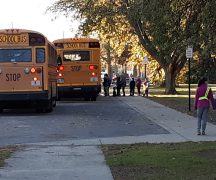By JAN LARSON McLAUGHLIN
BG Independent News
Some Bowling Green area voters find the school levy numbers disturbing – not the monetary numbers but the numbers of students that would be using one centralized elementary if the levy passes.
While some have protested the costs of the 5.7-mill levy spread out over 37 years, these citizens object to the merging of three elementaries into one centralized building. Supporters of the change say it will enable the district to provide consistency and equity in resources and opportunities for young students. Critics say students learn better in “neighborhood schools” as opposed to “factory schools.”
Both sides of the issue have presented their rationale. And as with most controversial issues, there is plenty of data to support both points of view.
Kimberly Christensen, of the Bowling Green State University College of Education and Human Development, said research shows pros and cons for smaller neighborhood schools and larger consolidated schools.
Centralized schools offer “higher educational quality as a result of the wider menu of educational experiences” they can provide, Christensen said. There is more consistency and greater equalization, she said.
In a building where all the grades are consolidated, the educational teams can offer more connected and integrated lessons, she said. The children benefit from having all the support staff and specialized teachers in one location, she added. For example, if a student needs to see the school therapist, the child won’t have to wait days until the therapist makes rounds to that school building.
And consolidated schools have higher fiscal efficiency, she said, since there are fewer redundancies.
Smaller schools, Christensen said, tend to do a better job of making students feel connected. Studies have documented better relationships are likely to occur in smaller settings. “Students feel supported and cared for,” she said.
Some research has shown reduced rates of student participation in extra-curricular activities in larger schools, Christensen said. And there are concerns about kids getting lost in the largeness.
“Are you going to see some left out of the process,” she said.
However, the latest trend seen in school districts seems to offer the best of both educational worlds, Christensen said. Districts are working to create small schools inside big consolidated schools.
“If you create that environment, it makes the larger school seem smaller,” Christensen said. With this model, students can benefit from academic teaming, access to all support staff, and more connectedness at the same time.
“As long as you can create that kind of intimacy of a small school in a bigger school,” she said. “It’s going to be so important to do that.”
Bowling Green Superintendent Francis Scruci has said from the beginning that the new building would be divided into three different schools – one wing for K-1, another for grades 2-3, and one for 4-5.
But opponents believe that 1,500 elementary students at one site is just too big. Supporters of smaller schools don’t deny that Bowling Green’s elementaries are currently lacking. They, however, would like to see the district spend money on improvements to the existing schools rather than building a new one.
Those supporting the levy believe sinking more money into the 60-plus-year-old elementaries is not a good investment and is just kicking the can down the road.
A consolidated elementary would mean consistent class sizes – which can’t be done now unless children are bounced from one school to another as class sizes fluctuate each year.
“I don’t think that’s what’s best for kids,” Conneaut Principal Jim Lang said of moving students.
Supporters of the levy say that Bowling Green may have had “neighborhood” schools years ago when there were six elementaries. But now there are three, and children travel across town to get to them.
And if the district can’t achieve equity through a centralized elementary, it may consider creating grade level buildings, Scruci has said.
But as it is now, classroom numbers vary greatly from one school to another. Conneaut’s kindergarten classes average 25, compared to Crim’s at 21, and Kenwood’s at 17 or 18.
Space is a huge problem in all three elementaries. Some special programs have to share rooms, and some teachers are crammed into spaces that are too small and have no storage. Currently, the Conneaut fourth grades use modular classrooms located behind the school. Next year, those modulars will be used for the preschool program that is now housed at Crim.
The consolidated elementary would be built to allow for growth, with room for 12 classrooms per grade level, compared to 10 now.
But those in favor of smaller elementaries suggest those space problems can be eliminated by adding onto the existing buildings. All of the elementaries have sufficient space for additions.
Children thrive in an environment where faculty, staff and fellow students know their names and who they are, say those opposed to a centralized school. Students have less chance of falling through the cracks in smaller schools, and less risk of being overlooked. Smaller schools feel like a second “family” to students – not an industrial warehouse.
But it’s more than physical space and classroom size, according to some. It’s about equity throughout the Bowling Green district – which has pockets of poverty. A consolidated elementary would give children educational equity, “regardless of where they are from,” said Ann McCarty, the district’s executive director of teaching and learning.
Despite efforts to unite the three schools under one “Bobcat Proud” banner, the mean-spirited nicknames and prejudices linger. The effort to balance classroom sizes a few years ago stirred up hard feelings when some children were moved from Conneaut to Crim.
The creation of one centralized elementary would erase those lines. It would get rid of the rivalry between the elementaries, and create a smoother transition for students as they enter middle school.
Those favoring smaller schools say the neighborhood buildings minimize the number of children who have to be bussed, and the length of those bus rides. By retaining the current sites, more students could walk or bicycle to the “neighborhood” schools.
However, the district has found that only 10 percent of elementary students walk or bicycle to school.





